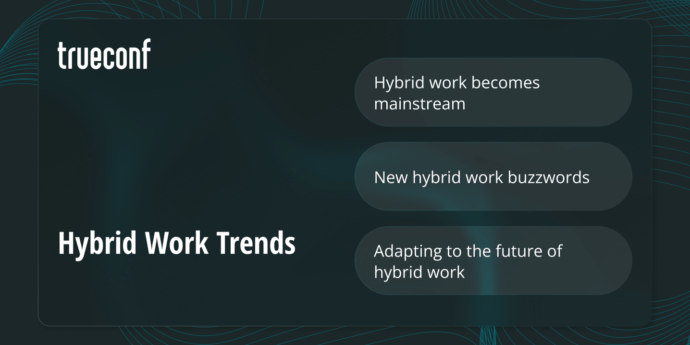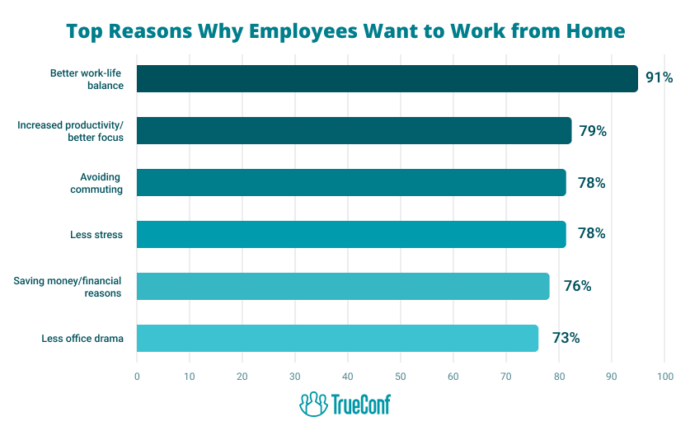Hybrid Work Trends 2025: From Flexibility to “Coffee Badging” and Beyond

Hybrid work has become the new normal in 2025, bringing with it fresh challenges and innovations. No longer a pandemic-era experiment, flexible work arrangements have stabilized at a “new normal” equilibrium.
For example, about 29% of all paid workdays in the U.S. are now done from home (virtually unchanged from late 2023). Roughly half of remote-capable employees are hybrid and another 30% fully remote, while only 20% remain office-bound.
This means most organizations have adopted some mix of in-office and remote work. As we head into 2025, it’s clear that hybrid work is here to stay – and it’s evolving in unexpected ways.
In this article, we’ll explore the key hybrid work trends of 2025, from big-picture shifts in workplace strategy to the quirky new buzzwords capturing what employees are really up to. Employers are shifting focus to outcomes and flexibility, while employees are asserting their work-life boundaries in creative (and sometimes sneaky) ways. Read on for the top trends shaping the future of work – and learn how understanding these trends can help your organization stay ahead of the curve.
Hybrid Work Becomes Mainstream (and Employee-Friendly)
1. Flexibility has gone from perk to baseline expectation
Surveys show a staggering 81% of employees prefer a hybrid or fully remote arrangement over a traditional office schedule. Companies enforcing five-days-in-office mandates are finding it harder to attract and retain talent in 2025. In fact, 83% of workers now say work-life balance is more important to them than salary – a clear signal that employees value flexibility and well-being. The message is loud and clear: to hire and keep the best people, organizations must offer autonomy in where and when work gets done.

2. Outcomes matter more than hours or location
Alongside the push for flexibility, progressive employers are abandoning the old “butts in seats” mentality. The focus has shifted to measuring results instead of time in the office. Many companies now set clear goals or OKRs and then trust teams to meet them on their own schedules. Some have introduced “core collaboration hours” for meetings and teamwork, leaving the rest of the day for flexible, deep-focus work. This results-oriented approach not only boosts productivity but also signals trust in employees – a crucial element when managing distributed teams. By prioritizing outcomes, managers are giving employees the freedom to schedule work around their lives, not the other way around.
3. Well-being and boundaries take center stage
With flexibility becoming standard, employees are also more openly prioritizing their mental health and personal lives. Many companies have responded by promoting work-life balance initiatives – from wellness programs to policies like “quiet hours” with no meetings. A culture of “always-on” availability is gradually giving way to one that respects personal time. Forward-thinking organizations recognize that a rested, happy employee is more productive and engaged, so they encourage taking breaks, using PTO, and setting boundaries in the workday. This emphasis on well-being is both a response to remote-work burnout and a competitive differentiator in employer branding.
4. Office spaces are being reimagined, not abandoned
Another trend in 2025 is the transformation of the physical office into a more purposeful collaboration hub. Since employees now come in by choice (often just 2–3 days a week), companies are redesigning offices to entice people to show up for meaningful interactions. Expect fewer assigned desks and more social lounges, co-working areas, and meeting pods. The goal is to make the office a “magnet, not a mandate” – a place people want to visit because it offers value (brainstorming, team bonding, client workshops) rather than just because it’s policy. In this way, the role of the office is shifting from a daily default to a special venue for collaboration and community-building.

5. Technology and AI are empowering hybrid teams
A robust digital infrastructure has become the backbone of hybrid work. Companies are investing in integrated platforms and smarter tools that make remote collaboration seamless. From project management suites and desk booking systems to video conferencing and virtual whiteboards, the tech stack needs to eliminate friction. Notably, AI is playing a growing role in 2025 – with around 80% of employees using or experimenting with AI at work. AI assistants help automate scheduling, transcribe meetings, or even analyze how office space is used. Emerging tech like VR/AR is also on the horizon for hybrid teams, promising more immersive remote meetings. By leveraging these innovations, organizations aim to bridge the gap between remote and in-person colleagues, ensuring everyone can contribute equally from wherever they are.
New Hybrid Work Buzzwords and Behaviors to Know
Coffee-badging – “Just stopping by the office for show.”
Coffee-badging is when an employee comes into the office only long enough to be seen – literally to grab a coffee, say hello, and then leave. It’s a cheeky tactic to appear compliant with return-to-office rules without spending a full day on-site.
According to a 2025 Owl Labs survey, 43% of hybrid employees admit they sometimes ‘coffee-badge’ – popping in briefly to check the attendance box before working elsewhere. Another 12% plan to try it. Most managers seem to be tolerating it: 56% of coffee-badgers who got “caught” said their employer didn’t mind, though 13% did face a unhappy boss (the remaining 31% haven’t been caught at all). Coffee-badging highlights the ongoing tug-of-war between strict office mandates and employees’ desire for autonomy.
Unbossing – “Opting out of climbing the management ladder.”
Unbossing is when workers intentionally decline or leave managerial positions to focus on personal goals or individual contributor work. In 2025, not everyone aspires to be the boss – in fact, about 32% of workers say they have engaged in “unbossing,” avoiding management roles on purpose. This trend is often driven by a desire for better work-life balance or to avoid the stress that comes with managing others. Interestingly, younger professionals are leading the charge here.
Surveys in the UK have found over half of Gen Z professionals refuse to pursue middle-management jobs at all. Rather than viewing this as a lack of ambition, many see it as a redefinition of success: valuing skill mastery, creativity, or entrepreneurship over supervising staff.
For organizations, “unbossing” might signal a need to create appealing career paths that don’t all funnel into management – for example, senior specialist roles with prestige and pay on par with people managers.

Quiet Quitting – “Working your wage, nothing more.”
Quiet quitting exploded as a buzzword in 2022 and continues into 2025 with roughly one in three workers saying they’ve done it. Quiet quitting doesn’t mean actually quitting your job – it means doing only the minimum requirements of one’s role and refusing to go “above and beyond” in unpaid overtime or extra duties. In a hybrid context, quiet quitting often manifests as employees setting stricter boundaries: logging off at 5 PM, not checking email on weekends, and generally refusing to let work dominate their life. This trend can be seen as a backlash against hustle culture and burnout. Notably, data suggests in-office workers are actually the most likely to quiet-quit (perhaps feeling disengaged or resentful of mandated office time), whereas fully remote workers are the least likely. The quiet quitting wave is a reminder for employers to keep workloads reasonable and employees engaged – or risk a workforce that does the bare minimum.
Polyworking – “Juggling multiple jobs or side hustles.”
A significant portion of the workforce isn’t content with just one job anymore. Polyworking refers to having more than one source of employment or income simultaneously – for instance, a full-time job plus a side gig (or even several).
This polyworking trend is fueled by various factors: passion projects, the gig economy’s ease of access to freelance work, or the need to supplement income amid economic uncertainty. Interestingly, hybrid and remote workers seem especially likely to polywork, perhaps because flexible schedules make it easier to fit in a side job.
For employers, polyworking can raise concerns about burnout or conflicts of interest, but it also indicates a workforce keen on diversifying their skills and income streams. Embracing polyworkers might mean ensuring clarity in contracts and balancing workloads, so secondary pursuits don’t detract from primary job performance.

Work-to-rule – “Sticking strictly to the job description.”
Work-to-rule isn’t a new concept, but it’s seeing renewed popularity in the hybrid era. Essentially, an employee works only to the exact letter of their job requirements and scheduled hours – no less, but definitely no more. Think of it as doing your job “by the book” and refusing any extracurriculars or overtime that aren’t compensated. Often, work-to-rule is a quiet form of protest by employees who feel overextended or taken for granted – for example, in response to stricter return-to-office policies or cuts in benefits, employees might withdraw any voluntary extra effort and limit their contributions to the bare minimum expectations. This trend overlaps with quiet quitting, though work-to-rule can be more intentional and even coordinated (in some cases, it’s used as a labor relations tactic). For employers, a rise in work-to-rule behavior is a red flag indicating lower morale or frustration among staff.
Clock-blocking – “Defending your calendar from others.”
Also known more politely as “calendar blocking,” this trend involves proactively scheduling out chunks of time on your calendar to prevent anyone from stealing that time. In a hybrid workplace where meetings can easily fill every open slot, employees have started blocking off time for their own focused work or even personal appointments – essentially creating unavailability.
For example, an employee might reserve 2-3 PM daily as a meeting-free period by marking it busy on the shared calendar, ensuring they can actually get work done or take a break. This can be a healthy time-management strategy to avoid burnout. In fact, many managers encourage setting “focus time.” However, when taken to extremes, calendar blocking can frustrate colleagues if half the team appears perpetually unavailable. The key is finding a balance, but the prevalence of clock-blocking underscores how much employees value control over their own schedules in the hybrid era.
Taskmasking – “Looking busy without being productive.”
In any office there have always been a few experts at pretending to work – but hybrid work has added new dimensions to this behavior. Taskmasking means creating the appearance of busyness – lots of task switching, attending meetings, frequent online presence – yet not actually accomplishing much of substance. It’s a form of “productivity theater” that has emerged partly as a response to remote tracking tools and micromanagement. With some companies using software to monitor active time or status indicators on Slack, employees have found ways to game the system (or just the boss’s perceptions) by ensuring they look constantly active.
Approximately 15% of workers admit to taskmasking – essentially faking productivity at times. Examples might include moving your mouse to stay “online,” joining lots of optional calls, or sending late-night emails that give the impression of long hours. For leaders, taskmasking is a reminder that hours logged do not equal results. It reinforces why focusing on concrete outcomes (not digital “presenteeism”) is critical – otherwise employees will find ways to appear busy regardless of actual output.

Hushed hybrid – “On paper, in-office; in practice, remote.”
As some companies tighten their return-to-office (RTO) mandates, a parallel trend of “hushed hybrid” has arisen. A hushed hybrid arrangement is an unofficial deal where managers quietly allow certain employees to keep working from home most of the time – even though officially the company might require in-person days. This usually happens under the radar: for instance, a boss might tell a high-performer, “It’s okay if you come in only when you need to, just don’t broadcast it.”
About 17% of workers report having a hybrid schedule that isn’t openly advertised (i.e. a hushed hybrid situation). These secret flex arrangements often arise to retain talent or accommodate individuals (like those with health issues or long commutes) despite one-size-fits-all office policies. The risk, of course, is resentment or perceived unfairness if coworkers notice some people “bending the rules.” Hushed hybrid scenarios put companies in a tricky spot, essentially running a quiet exception to the official policy. Long term, it begs the question: if a flexible setup works for certain employees, should it not be policy for all? In 2025, many organizations are still figuring out how to balance consistency with individual flexibility – and hushed hybrids are one messy result.
Quiet vacationing – “Taking time off on the sly.”
In the age of hybrid work, some employees have found ways to get a little R&R without formally taking leave – a practice dubbed quiet vacationing. This means using flexible remote work arrangements to appear online and “working,” while actually taking it easy or even traveling for leisure. Perhaps you’ve heard of people logging in from the beach or tuning into calls during what is effectively their vacation time. With blurred lines between home and work, about 17% admit to quiet vacationing – essentially resting on company time (without using up official vacation days).
For example, an employee might take a light week of remote work where they do the bare minimum, while treating it mentally as time off. Or they might call in sick but still send an email or two to look active, then go enjoy a day off. Quiet vacationing is another form of drawing boundaries – employees feel entitled to more downtime and are sometimes sneaking it if they feel regular PTO is insufficient or if they fear backlash for taking leave. The takeaway for employers is to foster a culture where people can take vacations without guilt. Otherwise, you get staff who are technically “working” but truly checked out, which isn’t good for productivity or honesty.

Adapting to the Future of Hybrid Work
The trends above paint a picture of a workplace in transition. Hybrid work in 2025 is not just about where people work, but how people work and relate to their jobs. On one hand, companies are learning to manage distributed teams by focusing on results, investing in better tech, and redesigning office space for intentional collaboration. On the other hand, employees are asserting their needs for flexibility, balance, and fulfillment – even if it means quietly subverting rigid rules through coffee-badging, quiet quitting, or other tactics
For employers and HR leaders, staying ahead in this new era will require a proactive and empathetic approach:
- Embrace flexibility as a competitive advantage: Rigid policies are increasingly a liability. Use hybrid work to access wider talent pools and keep your workforce happier. When 40% of employees say they’d job-hunt or even quit if flexible work was taken away, it’s clear that offering choice in where/how to work is essential for retention.
- Measure what matters: Double down on outcome-based performance metrics. If employees meet their goals and deliver results, how or when they got it done matters far less. Reducing reliance on surveillance or arbitrary office hour requirements can also cut down on counterproductive behaviors like taskmasking.
- Foster a culture of trust and well-being: Encourage open dialogue about workload and burnout. Create an environment where employees don’t feel pressured to engage in quiet quitting or work-to-rule protests because their concerns are heard early. Support managers in being flexible (within reason) – sometimes individual exceptions (hushed hybrid arrangements, for example) might be needed to retain a valued team member. The ultimate goal is a culture where employees want to give their best, not feel compelled to game the system.
- Leverage technology, but stay human: Adopt tools that make hybrid coordination easier – from scheduling apps to virtual collaboration platforms. But also be mindful of tech overload. Sometimes the solution is as simple as clarifying team norms (e.g. set “no meeting” blocks or encourage calendar blocking for focus time) so people can work effectively. And when new tech like AI comes in, provide training and ethical guidelines, so it’s enhancing work – not quietly monitoring or stressing out your staff.
- Be aware of emerging trends: Finally, keep an eye on these hybrid work buzzwords because they offer insight into employee sentiment. If you notice coffee badging or quiet quitting on your team, treat it as valuable feedback. It might indicate issues with engagement, office environment, or management style that you can improve. By staying attuned to these patterns, leaders can adapt policies before discontent spreads.
Hybrid work in 2025 is a balancing act – blending structure with flexibility, company interests with employee autonomy. Those organizations that find the right balance are poised to attract top talent and boost productivity, all while keeping their people happier. The workplace will continue to evolve, but one thing is certain: listening to employees and iterating on your hybrid strategy will be key to thriving in the future of work.
Related posts:
What is Hybrid Work and Why is it Needed?
7 Remote Work Challenges You Can Easily Overcome with Video Conferencing Software
The Advantages of Remote Working
About the Author
Olga Afonina is a technology writer and industry expert specializing in video conferencing solutions and collaboration software. At TrueConf, she focuses on exploring the latest trends in collaboration technologies and providing businesses with practical insights into effective workplace communication. Drawing on her background in content development and industry research, Olga writes articles and reviews that help readers better understand the benefits of enterprise-grade communication.




Follow us on social networks